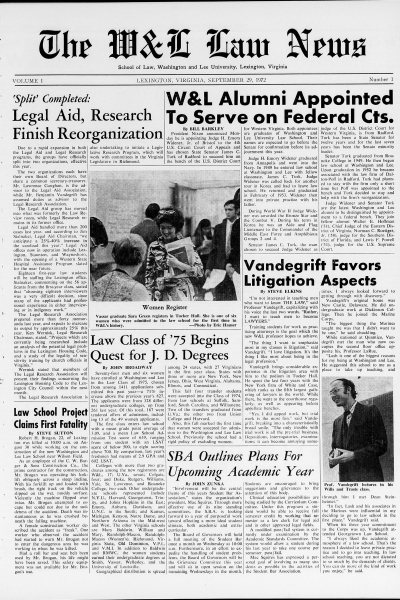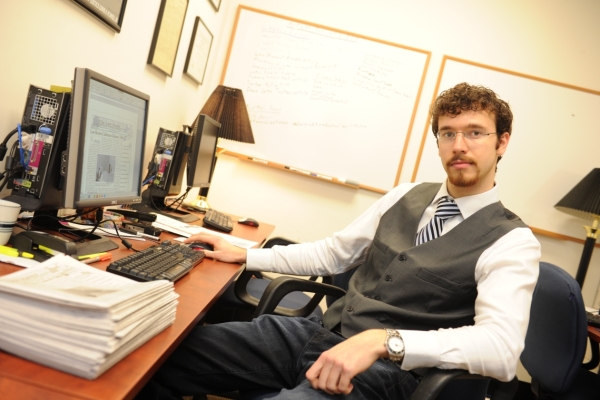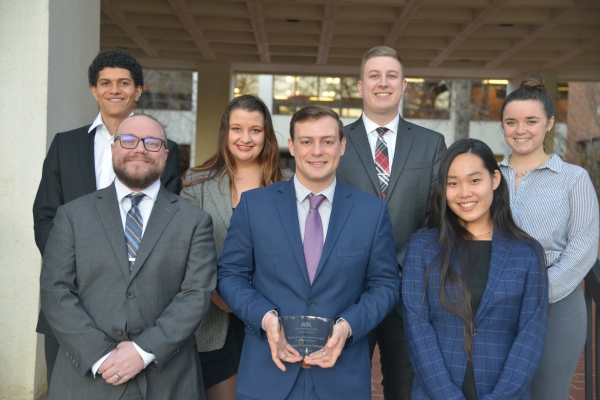50 Years of The Law News ‘Irreverence With Some Measure Of Reverence’
As origin stories go, the birth of The W&L Law News isn’t complicated. As Ken Wernick ’73L recalled, he and classmate Toby Harder were chatting in Tucker Hall one day in September 1972 when Harder said, “You know, I think we should start a newspaper.”
Wernick winced at the suggestion. He’d been managing editor of the twice-weekly Bucknell student paper. That meant he had the necessary experience to get a paper started. It also meant he knew what he’d be letting himself in for.
“I’d thought a paper for the law school would be a great idea, but I remembered how my grades sank at BucknelI. I wasn’t one of these people who’d come from a family of lawyers,” Wernick said. “I needed grades. I needed to be in the library, right? I was also facing the Army.”
But Harder, “Champagne Tony” as he was known, was persuasive. He assured Wernick that he’d put together a solid team to provide the stories if Wernick shepherded them through the mechanics of publishing.
So Wernick signed on as managing editor under Harder as editor-in-chief. Fifteen names were on the first masthead when Number 1, Volume 1 of The W&L Law News appeared on September 19, 1972.
The four pages comprised an assortment of hard news from around the law school (“Legal Aid, Research Finished Reorganization”), feature stories (“Lexington Eateries Offer Hometown Haute Cuisine”), and sports (“‘Roy’s Boys’ Seek Football Title”). The lead photograph on page 1 was historic: Sally Green Handley ’75L was shown registering for classes as one of the first six women entering W&L Law.
The masthead was modeled after The New York Times, and the lead editorial in the first issue laid the foundation for the next 50 years: “A newspaper so pompous or impertinent as to mimic the masthead of the New York Times should give the readers of its opening edition some hint of a memorable editorial policy. We could ape the Times (and some of our classmates) by spewing profound inanities on all subjects passing through our craw. But irreverence tempered with some measure of relevance seems a more palatable blend to serve up to you.”
Irreverence tempered with some measure of relevance was an apt vision statement. Over the next five decades the balance between those two — irreverence and relevance — has occasionally tipped more in one direction than the other.
The newspaper’s appearance at that moment in the law school’s history was appropriate to chronicle the many changes underway. As Wernick observed, “The women were coming; Dean (Roy) Steinheimer was flying around in his private plane recruiting students from all over the country; our reputation was growing beyond Virginia. The time [for a newspaper] was right.”
In 2013, Howard Wellons ’14L, then editor-in-chief of The Law News, interviewed Steinheimer as part of the paper’s 40th celebration of the paper. Wellon asked Steinheimer, known as “The Sky Dean,” what he remembered of the newspaper’s origins.
“There were turbulent times in the sixties, in all educational institutions,” Steinheimer told Wellons. “The newspaper sprang up because they felt they needed to have an additional means of asserting themselves. Well, I was happy to help them get organized. I didn’t put any blocks in their way. If they wanted a newspaper, fine, but they would have to have a way to operate it and so forth. And they did, and it was good.”
Like most student-run newspapers, The Law News has had its ups and downs. Some years there were plenty of staffers to share the load; some years the paper struggled to find its footing. In Professor Brian Murchison’s view, however, the paper has always been an asset. Murchison arrived at W&L in 1982 when the paper was in its second decade. He’d worked on the Yale Daily News and had helped launch a newspaper at the Yale Law School. Between those first-hand experiences and his scholarship in mass media and First Amendment issues, he has special insight into student media.
“I think The Law News has played an important role in talking about the community as a community of human beings,” said Murchison. “I always thought the newspaper added the kind of information that reflects a real community rather than just a professional school. It brought out the humanity of the place more than its legal accomplishments.”
At the same time, Murchison acknowledged the paper often had the irreverent streak that its founding editors promised. He described it as “properly irreverent” at times, which no doubt included the April Fool’s editions.
“It would satirize some of us on the faculty, which allowed people to let off steam,” Murchison said. “As a free speech teacher, I think part of why speech needs to be free is to let off steam and to let people relax. It had an information purpose and a kind of humor purpose.”
Before the paper’s birth in the pre-internet days, a primary communication tool for law students was a bulletin board above the drinking fountain in Tucker Hall. Announcements posted there were approved by “H.F.”
“The posts were marked either ‘H.F. OK’ or ‘H.F. Not OK.,’” said Sally Wiant ’75L, an emerita professor of law. “Maybe somebody knew who H.F. was, but I didn’t. When we moved to Lewis Hall, the bulletin board was locked under glass, and ‘H.F.’ couldn’t make the approvals.”
The Law News kept “H.F.” alive with its “Law School Advisor,” featuring tongue-in-cheek letters to “H.F.” and equally facetious responses, like this answer to “Desperate’s” complaints about not getting the right classes: “Dear Desperate, Nothing could be simpler. All you have to do is to sign up for all the courses offered for the semester. Then, after the semester has begun, drop all but the classes you intend to take.”
“That column had been passed down over the years,” said Dan Collopy ’81L, editor-in-chief in 1980-81. “All of us on the staff would take swings at both writing and answering questions to ‘H.F.”’
In addition to advice from H.F., early issues included a gossip column titled “The Fishbowl,” describing life in the small, insulated world of the law school. “You know the editor should probably not be the gossip columnist,” said Nan Robertson Clarke ’78L. “But I was willing to take it on from time to time. It was fun but probably not something you’d be able to do now.”
Clarke was the fourth editor-in-chief and the first woman in the position. Her first editorial declared: “We at the News … are not professional journalists; in fact, according to some of our readers we’re not even close. We work on the Rag not from financial or course-credit incentives and with scant hope of using it as resume fodder (particularly if the interviewer has ever seen a copy). We do it for the simplistic notion that we like doing it.”
Clarke acknowledges the paper of her day could not survive the internet era.
“Our newspaper wasn’t seen beyond the law school, and that was freeing. You could libel people — well, not really libel them — but you could poke fun and write stories without worrying that you were jeopardizing your career,” said Clarke. “Everyone seemed to love the paper. We didn’t get complaints, although I did get some grief when the man I eventually married (T. Hal Clarke ’73, ’76L) found I’d misspelled his name. He hasn’t let me forget that.”
In every era, The Law News provided students an outlet to write something other than briefs or memos. As Collopy explained, the staff would post a notice on the bulletin board outside the TV lounge soliciting stories for future issues.
“We got some interesting submissions,” he said. “One I still remember was the piece Nancyjean Bradford ’83L did on trying to figure out how Aquafresh toothpaste comes out of the tube with the symmetrical red, white and blue stripes.”
The toothpaste mystery aside, The Law News didn’t shy away from controversy. In its fourth issue, for instance, the paper’s lead story was about faculty “squatters” who were paying the same rent as married law students to live in the Davidson Park apartments. Later, there would be stories about a professor’s tenure denial, race relations at the university, Lexington Police Department practices, and the name of the university, among others.
“We wrote stories that were pretty straightforward,” said Paul Fletcher ’85L, editor-in-chief in 1984–85. “The story we wrote about a tenure decision did get some people mad, but I never had anybody from the administration call me on the carpet.”
Fletcher went from The Law News into a successful career in legal journalism. He was publisher and editor-in-chief of Virginia Lawyers Weekly for 33 years before becoming executive director of the Virginia Bar Association in 2021.
“Lawyers,” said Fletcher, “are storytellers. Lawyers and journalists have a lot in common — it’s just that lawyers get paid better.
“I had a number of reporters at Virginia Lawyers Weekly who were originally lawyers and were making the transition to legal journalism. One of the things I would tell them is to draw on their experience as lawyers. Interviewing is not unlike doing an examination, even a cross-examination. When you’re in a trial or at a deposition, you’re tapping into the same skills.”
Audrey Marcello ’02L, coeditor of the 2000-01 Law News with Meri Triades Pasztor ’02L, majored in communications and was features editor of the newspaper at LeMoyne College. Not only did she find that the writing style she’d developed as a journalist was valuable in law school, but she also recognized how a paper run entirely by students played an important role.
“It was challenging to squeeze the paper in with all our studies, which is why Meri and I were coeditors,” said Marcello. “I thought it was important for people to focus not just on their own studies but to know what was happening around them and not to rely on word-of-mouth. I think we see problems with that today.”
Although The Law News has successfully published 369 issues, it suffered a couple of near-death experiences in the past decade, only to be resuscitated by the infusion of energetic leadership. During his 1L year in 2012, Howard Wellons ’14L worried The Law News had reached its end.
“People weren’t interested in writing for it. People weren’t interested in reading it,” said Wellons. “The administration didn’t want the paper. They were tired of it and embarrassed by it.”
Wellons had been editor of Erskine College newspaper when that paper was in a similar experience. “I was in a position to revive the paper there and didn’t. I regretted that,” Wellons said, adding that he didn’t want similar regrets in law school. He took over at the end of his 1L year, recruited a new board and convinced the administration to give the paper another chance — and office space.
“We’d had great space, and it had been taken away. We ended up with what was essentially a closet,” said Wellons. “It was quite a comedown, but at least we were still there.”
When the first edition of the 2012-13 Law News appeared in October 2012, it featured a front-to-back redesign and promoted a year-long celebration of the newspaper’s 40th anniversary. In his first editorial, Wellons vowed to provide “faithful and insightful coverage of the events and issues facing the law school.” Amid the paper’s standard blend of feature and news stories were sprinkled pieces about the law school’s history and guest columns by previous Law News editors and writers.
In August 2013 the American Bar Association honored the paper with its top award for student-run newspapers and praised The Law News “for its long-term commitment to provide law students well-written and engaging content relevant to their studies, their future careers, and the legal profession in a thoughtfully designed newspaper.”
That was not the first time the ABA had recognized The Law News. Nor would it be the last. The current office on the second floor of Lewis Hall features a wall full of ABA awards. In addition to recognition for articles and editorials, the paper won the overall award in 1985, then three successive awards from 2012 to 2015, and once again in 2022.
Wellons increased circulation by sending the paper to alumni and launching its first website. He also worked with the Ring-tum Phi to have Law News articles republished on the undergraduate side.
“We wanted to give the law school community what it might not get in other places. You have so many outlets online that can get national, state, local news a lot faster and more comprehensively than you can possibly get in a campus newspaper,” Wellons said. “To get it read, you have to narrow your focus.”
One example was the paper’s coverage of the tragic automobile accident in which Lara Gass ’14L was killed in March 2014. The April 17, 2014, edition not only had a front-page story about the accident, but almost two pages of student-authored tributes.
“Lara’s death was devastating,” said Wiant. “We needed to grieve collectively, and that helped.”
The paper continued its successful resurgence in the 2014-15 when Mike Darmante ’16L succeeded Wellons as editor-in-chief. At Wellons’ invitation, Darmante had begun writing for the paper the year before he matriculated, making him the only four-year staff member.
“What I was most excited about with The Law News was the participation we got,” said Darmante. “I remember the first interest meetings I attended there were maybe 10 to 15 people in the room. When I left we filled an auditorium with people who wanted to write.”
COVID created another bump in the road since no Law News was published between October 25, 2019, and November 2021. When it did reappear, the paper had adopted a magazine format. Current editor-in-chief, John Coffron ’23L, said reviving the paper, post-COVID, was a massive undertaking.
“When we started, there were no style guidelines, no editing templates, and we spent hours and hours trying to figure out what looked good and what kind of style we wanted to use to bring it back to the publication it had been in the past,” Coffron said.
The work paid off when the 2021-22 paper won its latest National Achievement Award from the ABA.
Coffron said plans are to continue publishing at least twice, and perhaps three times a year, in the magazine format. Its look is different but, Coffron said, not its purpose.
“I think The Law News does a couple of things really well. One is that it gives students the opportunity to write for pleasure about issues that interest them,” said Coffron. “It also provides a platform for advocacy about the direction that we on The Law News want the school to go.”
Murchison agrees.
“Early on, it was to keep the community informed, but they weren’t looking that much beyond that,” he said. “Now, because of the internet, there’s a lot more going on beyond that. They have the luxury of being more reflective now. I always think, ‘Oh, good. There’s the latest issue. I want to read that because I always think I’m going to encounter a perspective I haven’t thought about.’”

 1981 Law News Staff
1981 Law News Staff Howard Wellons ’14L
Howard Wellons ’14L Current Editorial Staff of The Law News
Current Editorial Staff of The Law News
You must be logged in to post a comment.